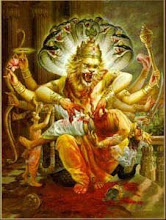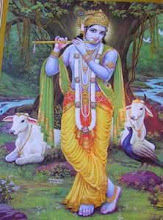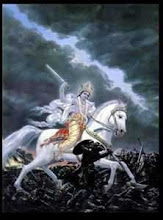The millions of Hindu Gods and Goddesses, to be exact 330 million, represent the various aspects of the Supreme Being – Brahman. In Hinduism, Brahman is the supreme soul of the universe, self-existent, absolute and eternal, from which all living and non-living emanate, and to which all return.
When a Hindu climbs up the ladder of knowledge, the concept of gods and goddesses begins to vanish and he/she will finally merge with the Brahman. So, in reality, there are no gods and goddesses in Sanatana Dharma or Hinduism. This is because the gods, goddesses and devotee all merge into the Brahman. Yes, this is hard to digest for an ordinary human being.
For an average human being, god is someone who helps to climb that extra yard. Who helps when in pain. Who helps to pass examinations. Who helps to get promotions. And who helps in all the desires that arise in the mind of a human being. So he/she cannot easily understand the concept of Brahman.
He/She needs something to concentrate upon and something to express the desires and the numerous gods and goddesses in the form of idols and images serve the purpose of concentration.
In the words of Sir C P Ramaswamy Iyer “Hinduism has recognized different stages of evolutionary progress in the case of several races and classes of mankind and has not only authorized but actually encouraged the adoration of pictures and images as a means of concentration.”
Thousands of years ago Sanatana Dharma or Hinduism flourished in an India (Bharat) which had many races and tribes. They worshiped multiplicity of objects, gods and goddesses and many of them were manifestations of different aspects of Mature Nature.
Take a look at the three main deities in Hinduism – Brahma, Vishnu and Shiva. Brahma creates, Vishnu sustains and Shiva destroys. They are nothing but three different faces of Mother Nature. Nature creates, nature sustains and nature destroys.
Each god and goddess in Hinduism is a path to reach the ultimate reality. If you are not happy with the 330 million, create a new god and pray to it. This new god will be a new path to merge with the Brahman.
Saturday, 26 July 2008
Ten Incarnations of Lord Vishnu in Hinduism and the Evolution of Human civilization
The ten incarnations or ‘Dasa Avatara’ of Lord Vishnu is an extraordinary recording of the evolution of human life and advance in human civilization. In Hindu religion, the three main deities are Lord Brahma, Vishu and Shiva. Brahma creates, Vishnu protects and Shiva destroys - three faces of Mother Nature. Lord Vishnu descends on Earth to uphold dharma and to cleanse the Earth of evil. So far, Lord Vishnu has appeared nine times on Earth and the tenth, kalki, is expected.
The sequence of appearance of Lord Vishnu on Earth is in tune with the evolutionary theory. In fact, the ten incarnations of Lord Vishnu is an amazing recording of the advancement of human civilization. All this was recorded by Hindu sages thousands of years before Christ.
The first incarnation or avatar of Lord Vishnu was in the form of a fish and is known as ‘Matsya Avatar.’ It has now been confirmed by Science through various experiments that the first life forms evolved underwater.
The second incarnation of Lord Vishnu was in the form of a tortoise known as ‘Kurma Avatar.’ Tortoise is an amphibious creature capable of living both on land and in water and it indicates the moving of life form from underwater to surface of Earth.
The third incarnation of Lord Vishnu is the boar known as ‘Varaha Avatar’. Boar is a complete land animal and in this incarnation, life form has moved out of water and has adapted to land.
The fourth incarnation of Lord Vishnu is the half-man half-animal form known as ‘Narasimha Avatar.’ This incarnation starts the transformation from animal to human form.
The fifth incarnation of Lord Vishnu is the dwarf or pigmy sized human being known as the ‘Vamana avatar.’ A transition from the beastly form to human form and the development of intelligence.
The sixth incarnation of Lord Vishnu is the forest dweller known as ‘Parasuram.’ He has developed weapons and axe is his first weapon. Any sharp stone can be transformed into an axe and it also indicates the first settlement of humans in forests.
The seventh incarnation of Lord Vishnu is Lord Ram. He civilized and has developed more superior weapons like the bow and arrows. He has cleared the forests and developed small communities or villages. He is very vigilant and protects his villages and people.
The eight incarnation of Lord Vishnu is Lord Balarama. He is portrayed with the plough – the beginning of full-fledged cultivation. Human civilization has developed agriculture and is no longer depended on meat and forest for food. The beginning of agrarian economy.
The ninth incarnation of Lord Vishnu is Krishna. He represents the advancing human civilization. He is associated with cows, the beginning of domestication of animals and development of economy, which continues to the present day.
The tenth incarnation of Lord Vishnu is Kalki and is yet to arrive. He is believed to ride on a swift horse Devadatha and destroy the world. A clear indication that human beings will bring an end to life on earth. The numerous natural calamities created by human beings and the numerous nuclear weapons stored illustrates this.
After complete annihilation, Lord Vishnu alone floats on a pipal life - perhaps the last remaining life form. Thousands of years after the complete annihilation, life will begin again in water.
The sequence of appearance of Lord Vishnu on Earth is in tune with the evolutionary theory. In fact, the ten incarnations of Lord Vishnu is an amazing recording of the advancement of human civilization. All this was recorded by Hindu sages thousands of years before Christ.
The first incarnation or avatar of Lord Vishnu was in the form of a fish and is known as ‘Matsya Avatar.’ It has now been confirmed by Science through various experiments that the first life forms evolved underwater.
The second incarnation of Lord Vishnu was in the form of a tortoise known as ‘Kurma Avatar.’ Tortoise is an amphibious creature capable of living both on land and in water and it indicates the moving of life form from underwater to surface of Earth.
The third incarnation of Lord Vishnu is the boar known as ‘Varaha Avatar’. Boar is a complete land animal and in this incarnation, life form has moved out of water and has adapted to land.
The fourth incarnation of Lord Vishnu is the half-man half-animal form known as ‘Narasimha Avatar.’ This incarnation starts the transformation from animal to human form.
The fifth incarnation of Lord Vishnu is the dwarf or pigmy sized human being known as the ‘Vamana avatar.’ A transition from the beastly form to human form and the development of intelligence.
The sixth incarnation of Lord Vishnu is the forest dweller known as ‘Parasuram.’ He has developed weapons and axe is his first weapon. Any sharp stone can be transformed into an axe and it also indicates the first settlement of humans in forests.
The seventh incarnation of Lord Vishnu is Lord Ram. He civilized and has developed more superior weapons like the bow and arrows. He has cleared the forests and developed small communities or villages. He is very vigilant and protects his villages and people.
The eight incarnation of Lord Vishnu is Lord Balarama. He is portrayed with the plough – the beginning of full-fledged cultivation. Human civilization has developed agriculture and is no longer depended on meat and forest for food. The beginning of agrarian economy.
The ninth incarnation of Lord Vishnu is Krishna. He represents the advancing human civilization. He is associated with cows, the beginning of domestication of animals and development of economy, which continues to the present day.
The tenth incarnation of Lord Vishnu is Kalki and is yet to arrive. He is believed to ride on a swift horse Devadatha and destroy the world. A clear indication that human beings will bring an end to life on earth. The numerous natural calamities created by human beings and the numerous nuclear weapons stored illustrates this.
After complete annihilation, Lord Vishnu alone floats on a pipal life - perhaps the last remaining life form. Thousands of years after the complete annihilation, life will begin again in water.
Lord Shiva as Pashupati
ashupati or Pashupatinath is one among the thousand and eight names of Lord Shiva and is mentioned in the Vedas. ‘Pashu’ in Sanskrit means animal and ‘pati’ means lord. Therefore Lord Shiva as Pashupati is the ‘lord of the animals.’ The most ancient representation of Pashupati is traced back to the Indus Valley civilization - a seal depicting a seated horned deity surrounded by animals.
Pashupati is applied mainly to Lord Shiva as he is the guardian of cattle, important wealth during the vedic and pre-vedic period. Pashupati is also the keeper of souls. He gives life and takes life.
One of the most important Pashupati temples is the Pashupatinath temple in Nepal.
The weapon of Pashupati is the Pashupata Astra.
Pashupati is applied mainly to Lord Shiva as he is the guardian of cattle, important wealth during the vedic and pre-vedic period. Pashupati is also the keeper of souls. He gives life and takes life.
One of the most important Pashupati temples is the Pashupatinath temple in Nepal.
The weapon of Pashupati is the Pashupata Astra.
Character of Hindu God Rama – Maryada Purushottam
Lord Ram is Maryada Purushottam – blessed with all the many good qualities which one can think of. The first chapter of Ramayana begins with Sage Valmiki’s search for such a person.
In the first of Chapter of Ramayan, Sage Narada finds Valmiki in deep thought and asks for the reason.
Valmiki answered: I wonder if there is, in this world of men, a single individual, a man blessed with all the many good qualities which one can think of.
Narada can enter everywhere even into the minds of people. And Valmiki knew that Narada would be able to answer his question.
Narada asked what these good qualities are.
“Integrity” said Valmiki. “Integrity, bravery, righteousness, gratitude, truthfulness, dedication to one’s principles, character without blemish, concern for all living beings, learning, skill, beauty, a pleasing appearance, courage, radiance, ability to keep anger under control, perfect control, a lack of jealousy at all times, undaunted heroism which can frighten even the celestials.”
This might sound a bit too much…. In fact Valmiki says to Narada “I know I am expecting perfection in a human being.”
But surprisingly Narada knew about such a man and that was Lord Rama. Narada then narrates the story of Lord Ram to Valmiki. And it is this story which later became the immortal epic Ramayana.
In the first of Chapter of Ramayan, Sage Narada finds Valmiki in deep thought and asks for the reason.
Valmiki answered: I wonder if there is, in this world of men, a single individual, a man blessed with all the many good qualities which one can think of.
Narada can enter everywhere even into the minds of people. And Valmiki knew that Narada would be able to answer his question.
Narada asked what these good qualities are.
“Integrity” said Valmiki. “Integrity, bravery, righteousness, gratitude, truthfulness, dedication to one’s principles, character without blemish, concern for all living beings, learning, skill, beauty, a pleasing appearance, courage, radiance, ability to keep anger under control, perfect control, a lack of jealousy at all times, undaunted heroism which can frighten even the celestials.”
This might sound a bit too much…. In fact Valmiki says to Narada “I know I am expecting perfection in a human being.”
But surprisingly Narada knew about such a man and that was Lord Rama. Narada then narrates the story of Lord Ram to Valmiki. And it is this story which later became the immortal epic Ramayana.
Why is Goddess Kali portrayed as drinking blood?
Talk about Goddess Kali and the image that comes to our mind is that of a fierce woman with blood dripping tongue. But why does Goddess Kali drink blood? Demons or Asuras through severe austerities obtain boons from Brahma. The demons often try to attain boons of immortality but Brahma often denies it. Instead the demons are given death under specific circumstances. The Asura Raktabeeja obtained a boon from Brahma that every drop of blood that falls on earth from his body will produce more demons.
The Devas could no longer fight Rakthabeeja and were on the receiving end. Finally, Mother Durga appeared as the terrifying Goddess Kali, who sucked up every blood that fell from Raktabeeja.
After destroying Raktabeeja, Goddess Kali remained blood thirsty and a horror to humans. Finally, Lord Shiva had to come down to earth to control her.
This is the reason why images of Goddess Kali are shown with blood red protruding tongue.
The Devas could no longer fight Rakthabeeja and were on the receiving end. Finally, Mother Durga appeared as the terrifying Goddess Kali, who sucked up every blood that fell from Raktabeeja.
After destroying Raktabeeja, Goddess Kali remained blood thirsty and a horror to humans. Finally, Lord Shiva had to come down to earth to control her.
This is the reason why images of Goddess Kali are shown with blood red protruding tongue.
Symbolism and Significance of the seven horses of Lord Surya
Lord Surya is the sun god in Hinduism. Important scriptures and mythology associated with Hindu religion contains several depiction of Lord Surya riding seven horses. The seven horses are known as Harits. Ratha Saptami is an important festival dedicated to Lord Surya riding seven horses.
In Hindu Mythology, Lord Surya rides across the heavens (sky) in a chariot drawn by seven horses. The horses symbolize the cosmic rays, which radiates warmth and life. As they move across the skies, they remove darkness and usher in light. The seven horses also symbolize the seven colors of rainbow.
The reins of the horses are firmly in the hands of Aruna (Sun God). The reins are the seasons and Aruna makes sure with the reins that rays of the sun sustain all living beings. The seven horses are also said to represent the seven days of the week.
The seven horses are often referred as Harits and sometimes instead of horses they are depicted as seven mares. Occasionally, they are also depicted as one horse or mare with seven heads.
In Hindu Mythology, Lord Surya rides across the heavens (sky) in a chariot drawn by seven horses. The horses symbolize the cosmic rays, which radiates warmth and life. As they move across the skies, they remove darkness and usher in light. The seven horses also symbolize the seven colors of rainbow.
The reins of the horses are firmly in the hands of Aruna (Sun God). The reins are the seasons and Aruna makes sure with the reins that rays of the sun sustain all living beings. The seven horses are also said to represent the seven days of the week.
The seven horses are often referred as Harits and sometimes instead of horses they are depicted as seven mares. Occasionally, they are also depicted as one horse or mare with seven heads.
Nine Characteristics of Lord Rama
The number nine holds a special place in Hindu religion – nine forms of Durga and Navratri celebration, the nine planets, and the nine ways of Bhakti (navavidha Bhakti).
Similarly, many Hindu devotees fast for nine days – from the first day of Chaitra to Ramnavami. Keeping the nine days or Ramanavami in mind the article takes a look at the nine important characteristics of Lord Ram.
1) Popularity
2) Bravery
3) Kindness
4) Justice
5) Obedience
6) Intelligence
7) Patience
8) Universal Love
9) Being Dutiful
The article explores each nine characteristics of Lord Ram in detail.
Lord Ram’s teaches us that physical beauty wanes with time, money is soon spent, fame is soon forgotten but generous deeds, great character and boundless compassion endure for all time.
His wish to do good for the people, even at personal suffering endeared him to the people more than elaborate speeches or ceremonies. His personal conduct spoke louder than mere words of philosophy.
Such is the glory of his memory that even now people invoke ‘Rama Rajya’ as the ideal, utopian system. It gave a democratic monarchy to the people. A system in which even the most humble may voice their opinion and be noticed.
Similarly, many Hindu devotees fast for nine days – from the first day of Chaitra to Ramnavami. Keeping the nine days or Ramanavami in mind the article takes a look at the nine important characteristics of Lord Ram.
1) Popularity
2) Bravery
3) Kindness
4) Justice
5) Obedience
6) Intelligence
7) Patience
8) Universal Love
9) Being Dutiful
The article explores each nine characteristics of Lord Ram in detail.
Lord Ram’s teaches us that physical beauty wanes with time, money is soon spent, fame is soon forgotten but generous deeds, great character and boundless compassion endure for all time.
His wish to do good for the people, even at personal suffering endeared him to the people more than elaborate speeches or ceremonies. His personal conduct spoke louder than mere words of philosophy.
Such is the glory of his memory that even now people invoke ‘Rama Rajya’ as the ideal, utopian system. It gave a democratic monarchy to the people. A system in which even the most humble may voice their opinion and be noticed.
Subscribe to:
Comments (Atom)



















